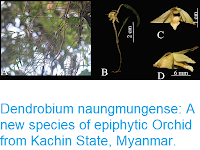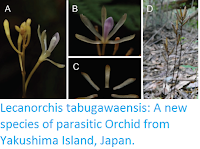Epidendroid Orchids, Epidendroideae, are the largest subfamily of Orchids, with over 15 000 described species, more than all other Orchid groups combined. The majority of these species are epiphytic (live on other plants, typically in the canopy of rainforest trees), though terrestrial forms are known. The group is found across the globe, with the exception of the polar regions, the deserts of Africa, Arabia and Australia, and the southern part of South America. The genus Bulbophyllum contains around 2200 described species from tropical regions around the world, and is thought likely to contain many more undescribed species. Members of the genus can be very difficult to tell apart when they are not in flower, as their vegetative parts tend to be much reduced, often with only a single leaf emerging from a pseudobulb (a pseudobulb, like a bulb, is an enlarged stem base used as a food store by a plant during dormant periods, but unlike a bulb is not found in the soil).
In a paper published in the journal Phytokeys on 13 November 2018, Lin Li of the Key Laboratory of Plant Resources Conservation and Sustainable Utilization at the South China Botanical Garden of the Chinese Academy of Sciences, De-Ping Ye of the Forest Bureau of Pu’er and Song-Jun Zeng, also of the Key Laboratory of Plant Resources Conservation and Sustainable Utilization at the South China Botanical Garden, describe a new species of Bulbophyllum from Menglian County in south-western Yunnan Province, China.
The new species is named Bulbophyllum chrysolabium, where ‘chrysolabium’ means ‘golden-lipped’ in reference to the flowers of the species. Bulbophyllum chrysolabium grows in Moss on the trunks of trees, with a creeping rhizome 2-3 mm thick that produces pseudobulbs every 3-5 cm, from each of which grows a single leaf 12-14 cm in length, as well as a raceme 5-6 cm in length and densely packed with flowers in December. These flowers are greenish-yellow with yellowish-orange or golden yellow lips, and give off an unpleasant, fishy smell.
The new species is named Bulbophyllum chrysolabium, where ‘chrysolabium’ means ‘golden-lipped’ in reference to the flowers of the species. Bulbophyllum chrysolabium grows in Moss on the trunks of trees, with a creeping rhizome 2-3 mm thick that produces pseudobulbs every 3-5 cm, from each of which grows a single leaf 12-14 cm in length, as well as a raceme 5-6 cm in length and densely packed with flowers in December. These flowers are greenish-yellow with yellowish-orange or golden yellow lips, and give off an unpleasant, fishy smell.
Bulbophyllum chrysolabium. (A) Habitat. (B) Inflorescences. (C) Close-up of inflorescence. (D) Flower, lateral view showing floral bract. (E) Flower, frontal view. Scale bars are 2 mm. Li et al. (2018).
Bulbophyllum chrysolabium was found growing at an altitude of 1400-1600 m in exposed positions near a river. Only about 30-50 clumps of the Orchids were observed, all within an area of about 4 km², though it is possible that there are other, undiscovered stands in the nearby forests, which were somewhat inaccessible. The area where the plants were found has no protected status, although it does receive some protection from the difficulty in accessing it. For this reason Li et al. suggest that Bulbophyllum chrysolabium be provisionally listed as Critically Endangered under the terms of the International Union for the Conservation of Nature’s Red List of Threatened Species.
Bulbophyllum chrysolabium, habit. Scale bar is 2 cm. Li et al. (2018).
See also...
Follow Sciency Thoughts on Facebook.








